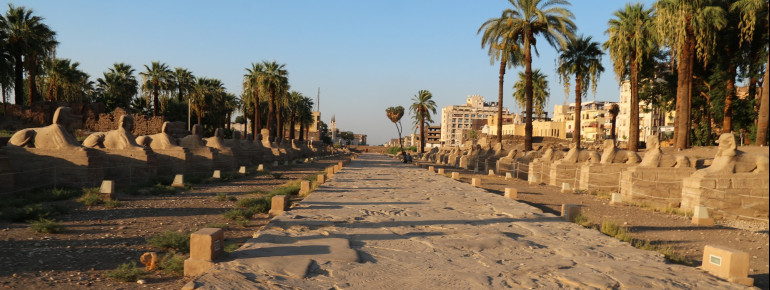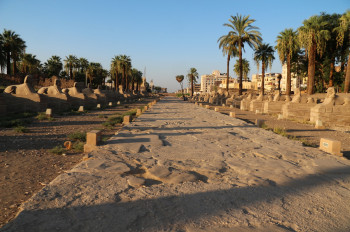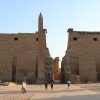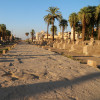Contents
Description
The Luxor Temple is one of the most important ancient Egyptian sights in the city of the same name. Like the larger temple complex in Karnak, the Luxor Temple was dedicated to the god Amun, his wife Mut and their son Chons.
The construction of Ramses II.
The temple is divided into several areas. Of particular importance is the Avenue of the Sphinxes, which connected the Luxor Temple with the temple complex of Karnak, two and a half kilometers away. To the southwest, the courtyard is bordered by a large pylon built by Ramses II. It consists of two thick, high walls on either side of the entrance and depicts the famous pharaoh's battle against the Hittites on the outside. In front of it once stood two seated figures, four standing statues and two obelisks. The two monumental figures as well as a statue and an obelisk are still preserved today. The second obelisk was given as a gift to the French King Louis-Phillipe by the then Sultan Muhammad Ali in 1836 - it is now located on the Place de la Concorde in Paris. In return, Muhammad Ali received a tower clock intended for the alabaster mosque in Cairo.
The first courtyard
Once you have passed the pylon, you enter the first courtyard, which consists of papyrus bundle columns. This type of ancient Egyptian architecture was widespread at the time and symbolizes Lower Egypt. A mosque was built over the eastern part of the courtyard. It stands about five meters above the ground level of the temple. This is because the temple was buried up to this height when the mosque was built. In the western courtyard area there is a chapel for Amun, his wife Mut and their two sons Chons, which was built by the Egyptian Queen Hatshepsut.
From the colonnade to the Holy of Holies
You then enter the colonnade, which is lined with seven by two papyrus bundle columns. The pharaoh statues and seating groups to the left and right of the entrance depict Amun and Courage. The following second courtyard was built by Amenophis III, followed by another portico to the south. The reliefs on the columns show Amenophis III at his coronation before the local gods of Thebes (today's Luxor). In the middle, you then pass through the door into the temple's Holy of Holies, a small room that only the high priest was allowed to enter.
Historical Information
The Luxor Temple was built at the time of the New Kingdom, between 1550 and 1070 BC. Together with the Karnak Temple and the necropolis of Thebes (Valley of the Kings), the temple has been a UNESCO World Heritage Site since 1979.
Construction history during the Egyptian pharaohs
It is assumed that a sanctuary was built on the site of the Luxor Temple as early as the 12th dynasty in Egypt's Middle Kingdom. The current southern part of the complex was built by Amenophis III and includes the sanctuary, the hall of columns and the second courtyard. Construction of the colonnade also began at this time. Akhenaten then had the temple closed and removed the name of the god Amun from the walls, as he wanted to establish a new monotheistic faith around the sun god Aten. His son, the famous pharaoh Tutankhamun, returned to the old faith and continued to expand the Hall of Columns. The monumental statues and the obelisk in the first courtyard were made by Ramses II. The courtyard in front of the pylon was decorated by Nektanebos I.
Functions of the temple
The temple had two functions: The Opet festival took place here on Egyptian New Year's Day. The statues of the family of gods were brought here from the Karnak temple, two and a half kilometers away, in portable barques. The festivities initially lasted eleven days, later 27 days. The Luxor Temple also served to unite the king with his divine Ka, the part of the soul that survives death and continues to exist independently afterwards.
Later changes to the temple building
When Alexander the Great conquered Egypt, he had the sanctuary converted into a chapel. During the Roman period, a fortress was finally integrated into the temple complex. In the post-Christian centuries, four churches were added to the site.
Interesting facts
- Luxor Temple is among the 3 best rated Tourist Attractions in Egypt.
How to get there
As a tourist, you usually visit the Luxor Temple accompanied by an experienced local guide. You will then be taken to the temple by coach from one of the Nile boats or from the tourist resorts on the Red Sea. You should only explore the temple or the city of Luxor on your own if you already know your way around Egypt. On the one hand, the travel guide can give you important historical background information about the temple, and on the other hand, this will also ensure that you arrive there without any accidents. Egyptian cities, including Luxor, usually have quite chaotic traffic. However, if you prefer to travel alone rather than in a tour group, you can also take a cab.








